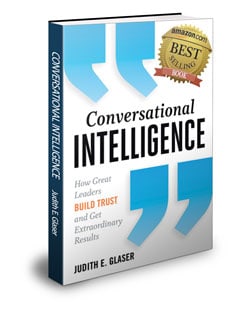
I’ve been reading this book “Conversational Intelligence” by Judith E. Glaser, and I highly recommend it!
We are first exposed to Intelligence Quotient (IQ), and subsequently learnt that Emotional Intelligence Quotient (EQ) was as important, if not more important, to a person’s success. I’d like to introduce what Judith calls “Conversational Intelligence Quotient (C-IQ)” in her book.
The premise of Conversational Intelligence is : “To get to the next level of greatness depends on the quality of our culture, which depends on the quality of our relationships, which depends on the quality of our conversations. Everything happens through conversations!”
– Judith E. Glaser
There’s a lot more to what Judith wrote in her book, but here are some of the key things that were insightful to me:
Shifting from “I-Centric” to “We-Centric” Behaviours
There are 3 levels of conversations that we can have with others:
- Level 1 – Transaction
Focus: Confirm what you know
Behaviour: Ask/Tell - Level 2 – Positional
Focus: Defend what you know
Behaviour: Advocate/Inquire - Level 3 – Transformational
Focus: Discover what you don’t know
Behaviour: Share/Discover
To build greater trust, we need to shift from being I-centric to We-Centric. Now I like the “We-Centric” description because there are times when people take it too far and turn it into “You-centric”. Personally, I think that doesn’t last very long, and it doesn’t really sustain trust in a long-term relationship with someone.
Our 5 Brains
I’m not sure if this is biologically true, but the 5 brains models is a good way to think about how we think (pun unintended).
- The Reptilian Brain
Function: Informs us about threats (physical and psychological) to our safety (amygdala).
Focus: Protect
Key Question: How do I protect myself, and do I need to? - The Limbic Brain
Function: Helps us identify our friends and our foes and lets us know how to fit in; it is concerned with needs, emotions, and relationships
Focus: Connect
Key Question: Who loves me, who hates me, and can I trust this person? - The Neocortex
Function: Sorts through data from our senses, memories, and experiences, and helps us make sense of our reality – promotes understanding
Focus: Belong
Key Question: Where do I belong and fit in? - The Heart Brain
Function: Our oldest brain, reads the biochemistry of our bodies and enables us to translate the energetic and hormonal messages that arise as we interact
Focus: Be Strong
Key Question: What do I need to learn to be successful? - The Prefrontal Cortex, or Executive Brain
Function: Engages us with the outer world and the future, helping us grasp inner and outer truths. By translating current information, impulses, and biochemistry, it helps us make judgement calls, have empathy, and anticipate the future, what we call foresight.
Focus: Partner
Key Question: How do I create value with others?
Building TRUST
To make the shift from I-Centric to We-Centric, we need to build TRUST, and address all of the 5 brains.
- Transparency (Language of the reptilian brain)
- Relationship (Language of the heart brain)
- Understanding (Language of the limbic brain)
- Shared Success (Language of the neocortex)
- Testing Assumptions and Truth Telling (Language of the prefrontal cortex)
FORCES that impact TRUST
There are dynamics, or FORCES that impact the building of trust:
- Fairness: Does this interaction and relationship feel fair – are we establishing a “WE” or is this relationship about “I”? Are we sharing in the “food for thought”?
- Ownership: Do we have a sense of ownership – a stake in the ground – and is it clear what is mine and what is yours? Do we have rules of engagement regarding ownership?
- Reciprocity: Do I care for you and you for me? What are the positive actions we take on each other’s behalf?
- Cooperation: In what ways do we join forces and work to support each other in achieving our needs?
- Expression: Do we give each other room to speak up and share what’s on our minds? Do we give each other space to speak our thoughts?
- Status: Do we honour where we stand in the social hierarchy, and do we respect each other for where we stand?
Putting it together
That’s a lot of information, and I haven’t even completed the book yet! But in summary, I’m looking at how I can use the FORCES to build TRUST, and move from I-Centric behaviours to WE-Centric Behaviours, so that we can move the quality of our conversations to Level III (Transformation) as often as possible!
I hope you found this very brief summary useful, and once again, I highly recommend reading the book. It may just change the quality of your conversations, which changes the quality of your relationships, which changes the quality of your culture, which propels you to the next level of greatness!
